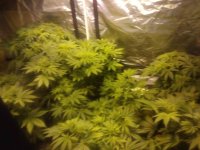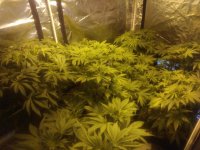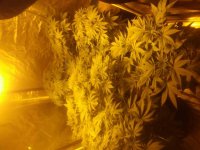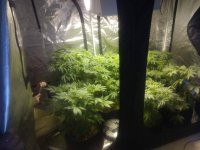Sweetdog760
Member
-microbeman... An avacado eating dog is a healthy dog. I actually heard somewhere that avocados are toxic to dogs but with all the stuff ive seen her eat I would be wholy amazed if it was an avacado that did her in.
I'm pretty sure flowering depends on the variety. My tree started dropping usable fruit around late october, early novemberish. But my grandmother has a tree thats been there for as long as I can remember and that one has is drops fruit all summer long. We're only about 5 miles away from each other and generally at the same elavation so I can't really attribute it to any thing else. The mexican higjlands is a beautiful area. I habe family from juanaguato...I'm sure I didnt spell that right.
The worms do eat the skins but it takes much longer. I'm pretty sure it comes down that the skins just tougher and denser so they take longer to break down. If I dig out a skin theres usually a clump of worms inside it. I will say that I have very thin skimmed avos. Something like a Hassan ( which is more of a commercial avacado with a thicker skin do better for shipping) would prob take even longer to break down. Drying and pondering the skins wouldn't be a bad idea. I used to blend scraps up and the worms loved that and would consume pretty much everything I put in there pretty quickly. Now I don't go through all that effort and I just throw some food in amd cover it with hay. Ive got brocolli stocks that I swear must be 2 months old just sitting there untouched still.
Bummer sbout your garden. Hopefully you fix it up before spring time. If you're lazy like me you could just throw out some layers of hay( or leaves whatever) and compost and have good usable soil in a few months. Its not the prettiest way to plant a garden but it couldn't get much easier.
And selling trees is a fantastic idea. Jus be aware that from seed to fruit youre talking s few years at best. I read something yesterday when I was looking for nutrition content on the seeds that mentioned starting avo from cutting. That might be a good option too.
A little nutrient profile of avo seeds:
NUTRITION INFORMATION FOR AVOCADO SEEDS
(per average sized pit)
95 calories
25 g carbohydrate
17 g starch
6 g fiber
2 g sugar
1.5 g protein
0.5 g fat
240 mg vitamin C (400% DV)
163 mg potassium (5% DV_
16 mg magnesium (4% DV)
7 mg calcium (0.7% DV)
Sources:
Antioxidant activity and phenolic content of selected fruit seeds. Food Chemistry (2004) 88(3): 411-417.
Antioxidants in ‘Hass’ Avocado. South African Grower’s Association (2007) 30: 17-9.
Avocado (Persea americana) seed as a source of bioactive phytochemicals. Curr Pharm Des (2013) 19(34): 6133-40.
Variations in the Composition of Avocado Seed. California Avocado Society (1951) 35: 139-152 .
-big nasty...I like the name. Thanks for visiting. Sea Salt is a good source of micro and macro nutrients. Don't quote me on it but I think theyre just about all in there. Its pretty diluted I really dont think it will hurt. And sea water is the primary source of micro nutes in knf farming. I actually kind of regret buying it because I'm literally 5 minutes from the beach. Heavy metalz and arsenic can be found in slot of soils and foods. Its not really an issue except with rice becauze it stores the arsenic better than most other plants. Poisons are only poison when theyre in a high enough concentration. I guess I didnt really look into it that much though. Pretty sure I heard aboit sea-90 from boogie brew...I think. Dude uses it in his teas. But...what do I know. You could be right. I haven't really done any solid research.
I'm pretty sure flowering depends on the variety. My tree started dropping usable fruit around late october, early novemberish. But my grandmother has a tree thats been there for as long as I can remember and that one has is drops fruit all summer long. We're only about 5 miles away from each other and generally at the same elavation so I can't really attribute it to any thing else. The mexican higjlands is a beautiful area. I habe family from juanaguato...I'm sure I didnt spell that right.
The worms do eat the skins but it takes much longer. I'm pretty sure it comes down that the skins just tougher and denser so they take longer to break down. If I dig out a skin theres usually a clump of worms inside it. I will say that I have very thin skimmed avos. Something like a Hassan ( which is more of a commercial avacado with a thicker skin do better for shipping) would prob take even longer to break down. Drying and pondering the skins wouldn't be a bad idea. I used to blend scraps up and the worms loved that and would consume pretty much everything I put in there pretty quickly. Now I don't go through all that effort and I just throw some food in amd cover it with hay. Ive got brocolli stocks that I swear must be 2 months old just sitting there untouched still.
Bummer sbout your garden. Hopefully you fix it up before spring time. If you're lazy like me you could just throw out some layers of hay( or leaves whatever) and compost and have good usable soil in a few months. Its not the prettiest way to plant a garden but it couldn't get much easier.
And selling trees is a fantastic idea. Jus be aware that from seed to fruit youre talking s few years at best. I read something yesterday when I was looking for nutrition content on the seeds that mentioned starting avo from cutting. That might be a good option too.
A little nutrient profile of avo seeds:
NUTRITION INFORMATION FOR AVOCADO SEEDS
(per average sized pit)
95 calories
25 g carbohydrate
17 g starch
6 g fiber
2 g sugar
1.5 g protein
0.5 g fat
240 mg vitamin C (400% DV)
163 mg potassium (5% DV_
16 mg magnesium (4% DV)
7 mg calcium (0.7% DV)
Sources:
Antioxidant activity and phenolic content of selected fruit seeds. Food Chemistry (2004) 88(3): 411-417.
Antioxidants in ‘Hass’ Avocado. South African Grower’s Association (2007) 30: 17-9.
Avocado (Persea americana) seed as a source of bioactive phytochemicals. Curr Pharm Des (2013) 19(34): 6133-40.
Variations in the Composition of Avocado Seed. California Avocado Society (1951) 35: 139-152 .
-big nasty...I like the name. Thanks for visiting. Sea Salt is a good source of micro and macro nutrients. Don't quote me on it but I think theyre just about all in there. Its pretty diluted I really dont think it will hurt. And sea water is the primary source of micro nutes in knf farming. I actually kind of regret buying it because I'm literally 5 minutes from the beach. Heavy metalz and arsenic can be found in slot of soils and foods. Its not really an issue except with rice becauze it stores the arsenic better than most other plants. Poisons are only poison when theyre in a high enough concentration. I guess I didnt really look into it that much though. Pretty sure I heard aboit sea-90 from boogie brew...I think. Dude uses it in his teas. But...what do I know. You could be right. I haven't really done any solid research.







